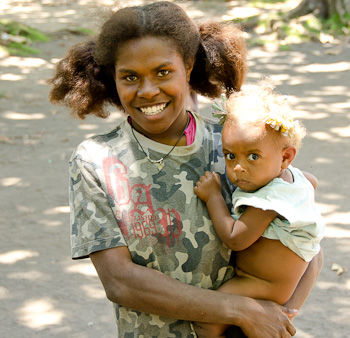
Tenaya
September 2011
Part Seven
My Friend Marie
Tanna, Vanuatu
| |
| HOME |
| About Tenaya |
| About Us |
| Latest Update |
| Logs from Current Year |
| Logs from Previous Years |
| Katie's View |
| Route Map |
| Links |
| Contact Us |
![]()
October 6, 2011
All her corn had been eaten by a cow. Marie was so sad after hearing the news from her mother that she did not want to go to her garden and see the devastation with her own eyes. She had not been there until now.
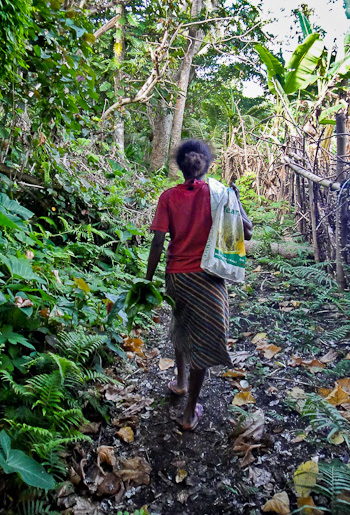
We first met when I stopped to say hello to a group of women sitting together at Port Resolution. I liked her right away. She had quickly noticed my basket as the quality is superb and most yachties carry daypacks, not baskets. I said that my friend from another village made it for me. She seemed surprised and admired it approvingly. We talked again after I translated for the French couples wanting to visit the volcano. Stanley organizes the trips but was in Lenakel so his sister, Marie, stepped in. When I said I would like to see a garden she offered to take me to hers the next morning.
As we walked along the well-worn path and then the road out of the village and towards the bush we talked about the different types of fruit and vegetables grown there. Taro, yams, manioc, cucumbers, tomatoes, bananas, paw paw (papaya) two kinds of sugar cane, choco, long beans, mangos, breadfruit...the list goes on.
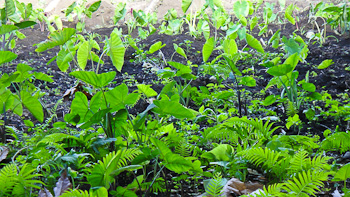
Eventually we reached a large garden where a man's voice said something softly in the local language. She answered just as quietly and did not look around. I never saw him. They do that, speak in low tones. I made a mental note to keep my voice down.
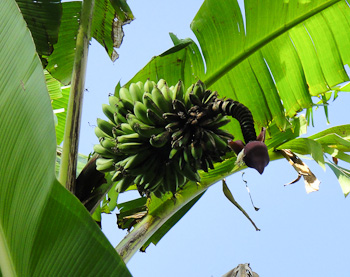
After a few more paces she stepped off to the left onto a barely perceptible path of slightly trampled vegetation. She glided effortlessly over and under live, sometimes prickly, often substantial obstacles while I tromped and maneuvered clumsily behind. I tried not to step on anything with a leaf as it all looked important. Finally she pointed out that I was dancing around weeds.
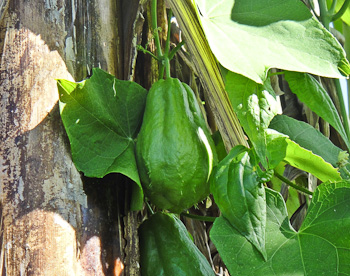
Marie pointed out the tree which choco grows on, my new favorite fruit or vegetable. I'm not sure which it is. This is the perfect food for a boat! Peel it and cut it up for a salad or slice, boil and serve it with coconut milk, or drizzle a little olive oil over it and bake with yams and an onion. Or simply eat it by itself. The texture and color is similar to the harder flesh of a cucumber but the taste is sweeter and much nicer, and it only has one big seed. Marie said it is a good food for traveling as it holds up well. Traveling here means walking great distances or being jostled about in the bed of a small 4WD pick-up truck.
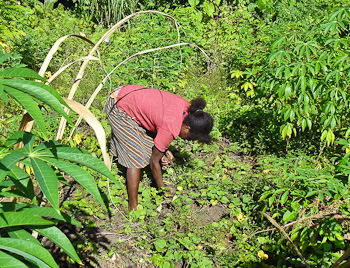
She wandered off often to dig something out of of the soft soil with her hands, snap a yam off, or cut out a taro root, leaf and all. When she couldn't reach the paw paw I twisted them off for her. She said solemnly that someone had stolen some. I wondered if it had been another yachtie thinking they were free for the taking.
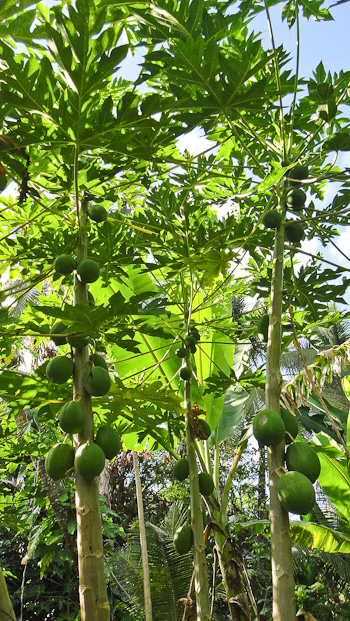
She asked if I liked sugar cane and when I answered yes she headed over to a small stand. Thinking this might make a good photo, I pulled out my camera. By the time it was ready she had sliced out a stalk, hacked the leaves off, and was in the process of whittling it down to a manageable size with her very substantial bush knife. She sliced it in half and handed me a piece. I watched as she bit into it, skin and all, and ripped a section down to the joint. She chewed, then spat out the woody part. I did the same. Tasty, but it wouldn't have occurred to me that the outer part should be ripped off with my teeth. The more I ate, the more I liked it.
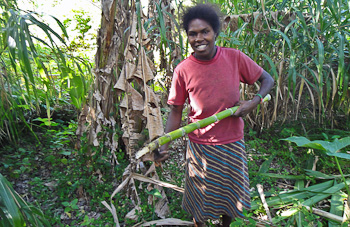
A bit more tramping led us past Stanley's and then Johnson's gardens before we reached hers. She stood quietly looking at the pitiful bits of green poking up from the ground. Her corn had been nibbled down to small stalks no more than six inches high. It had been growing nicely after she'd replanted what the cyclones had wiped out several months ago. I wanted to make it all better for her, to magically make tall rows appear like those in the vast fields of Wisconsin.
She said family members get together and all work together in one garden so they can get a lot accomplished. I considered volunteering to help rebuild hers but thought I might be more trouble than help as I possess not a single gardening skill.
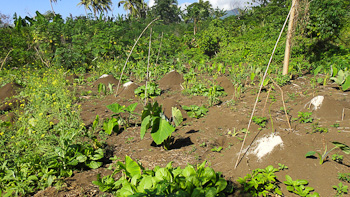
Marie explained that the white sand sprinkled on the mounds of new yams was to keep the soil from getting too hot and burning the plants.
By the time we walked past her mother's garden again she had a big rice bag full of produce. I offered to carry it, but when it cut painfully into my hands she hung it on the sugar cane and we each carried an end back to her village.
On the way I asked what she could use that I might have on board. She stopped and looked at me with a smile and said "I want you to make me a cake." "Okay, banana, white or chocolate?" Chocolate was the reply with a bigger smile. No problem. Little did she know I've gone 50 years without ever making a chocolate cake from scratch. But somehow now I felt inspired to steer clear of boxes and cans.
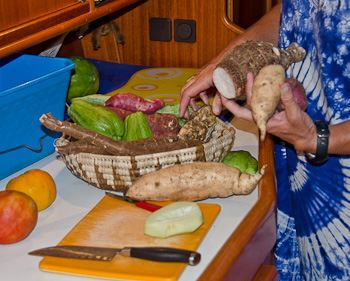
When David asked Jim if he could spare some rope so he could tie his cow to a tree, I urged Jim to give some up. Perhaps this was the errant cow that ate Marie's corn. Maybe we could stop it from further pillaging.
Before he died two years ago, Marie's father, Chief Roni, had told her that yachties should not be charged for produce. It should be given freely. Given, not taken. He felt very strongly about this. Should someone feel compelled to give something in return, that would be much appreciated.
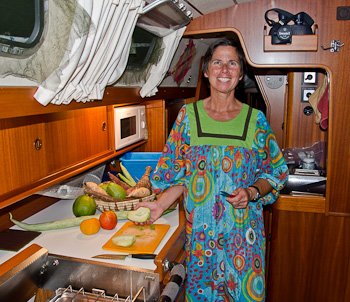
As we walked back from the gardens we passed through a village where I met their chief, Sam, and his wife, Jocelyn. Jocelyn spoke excellent English and offered to cook laplap for the ladies in the anchorage. I thought that sounded like fun. Marie was not impressed with the woman. "She charges people for the food she makes them." Obviously this was bad in Marie's mind. I did not pursue Jocelyn's offer.
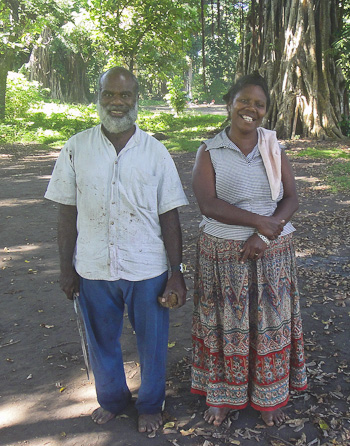
I explained that we are used to paying for services and opportunities like that, and I did not see it as bad. It is an idea that I might have suggested to help them make some money, but I'm sure glad I did not mention that.
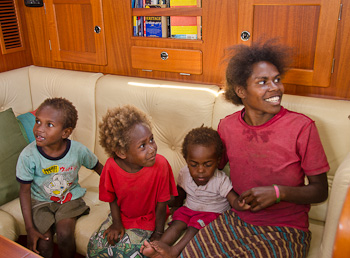
I asked if she'd been on a yacht. She had not. I'm always surprised when local people who have so much contact with yachties have never been invited on board. "Would you like to come out and see Tenaya?" I asked. Another big smile, "Yes!" So once Jim arrived to pick me up she and little Ruben, Noumi and Ron hopped in the dinghy and off we went.
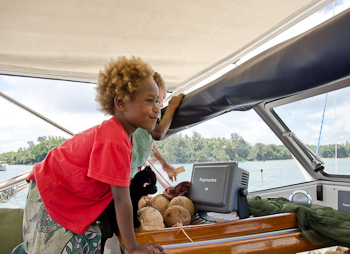
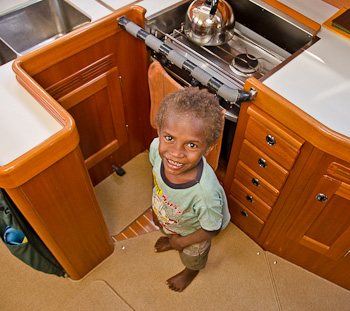
The kids were all eyes and smiles. They explored the main salon and on deck while Marie and I chatted over crackers and coke and Jim took pictures. I opened up our "pantry" which is under the port settee and she was gobsmacked at the quantity of food we have. Clearly, she's never seen so many cans of food or packages of flour and rice in one place. I tried to explain that we are loaded for months and months of self-sufficiency but I'm not sure she could comprehend the concept. We filled a bag for her to take back to the communal kitchen before Jim dinghied them back to shore.
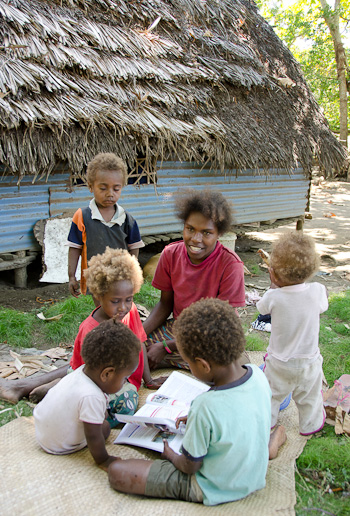
Some pigs roam freely through villages while others are penned up. As we were settling down on a mat under the shade of a tree, a gray pig wandered up, sniffed around and plopped down to sleep, or so it seemed.
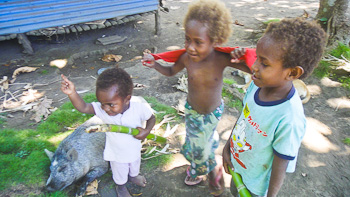
After several minutes of sedate inactivity, the pig jumped up, grabbed a banana leaf in its mouth and took off at full speed. Noumi was right on his heals while the other kids squealed and hollered. Swatting her shirt at its backside convinced it to drop the leaf. All was quiet again and the pig did not return.
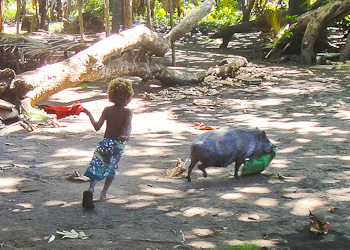
That evening I made two round chocolate cakes thanks to the instructions on the back of the box of Trader Joe's cocoa and an icing recipe from Amanda's cookbook. I sliced into one only to make sure the other was a worthy present.
The next morning we took the cake in to Marie and she gave me some eggs. She seemed busy and we wanted to wander along the beach so didn't stay long.
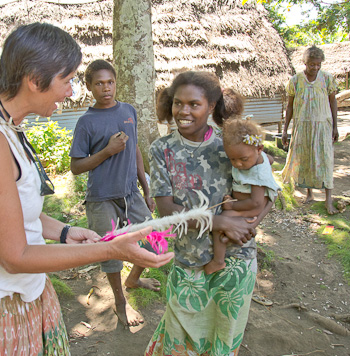
The next day she gave me a lovely large basket and two beautiful feathers. One is dyed pink, green and yellow and is worn by women during ceremonies when they dress in traditional costume. The other is made of white chicken feathers.
Later Kelson explained that receiving the feathers was a very big deal, especially the white one. It is only worn by the family of the chief during ceremonies. Wow. I will treasure these!
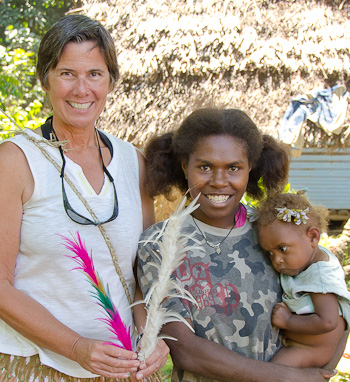
It is with a heavy heart that I write this now. I am in Pt. Vila and I left without saying goodbye to my friend.
We arrived back on Tenaya Thursday afternoon after spending a few days with Kelson and Charlie in their traditional village, a two hours' walk from Port Resolution. The following morning I awoke with a badly infected finger and we left as quickly as possible to reach the hospital in Vila before noon the next day. With cyclone season approaching, we do not have time to return. I am very sad about that.
Go to September 2011 Part Twelve - Epilogue Tanna, Vanuatu
Photo Gallery: Ikquramanu Village, Tanna, Vanuatu
Photo Gallery: Vanuatu Children